
GC liners
TOPAZ Liners
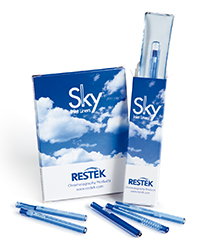 True Blue Performance
True Blue Performance
Exceptionally inert, Topaz™ inlet liners, with a new state-of-the-art deactivation,improve trace level analysis.
- Increase accuracy and precision.
- Lower detection limits.
- Use wool with confidence.
When faced with complex choices, simple solutions stand out. TOPAZ™ inlet liners from Restek use a comprehensive, state-of-the-art deactivation and are the only blue liners on the market-making them an easy-to-recognize solution to common inlet problems.
The innovative deactivation used for TOPAZ™ liners results in exceptional inertness for a wide range of analyte chemistries. By reducing active sites and enhancing analyte transfer to the column, these liners increase accuracy and precision, allowing lower detection limits for many active compounds. In addition to improved data quality, you’ll benefit from fewer liner changes and less downtime for maintenance.
Selecting the right liner for your application can be a challenging task. TOPAZ™ inlet liners make the choice simple; the comprehensive deactivation, distinctive colour, and availability in popular configurations mean TOPAZ™ liners are the best choice for optimizing chromatographic performance. Regardless of your application, TOPAZ™ liners provide reliable inertness and assured performance, dayafter-day and analysis-after-analysis.
GC liners
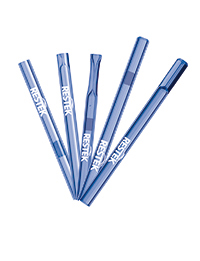 For most chromatographers poor sample reproducibility and mass transfer onto chromatographic column are generally the most critical issues in the method developement. Among others poor reproducibility and mass transfer can be caused by the degradation of the compounds by the glass inlet liner or by means of insufficient vaporization. Therefore selection of proper GC liner is very important and depends on the injection technique. Here you will find important information helping you with selectionof proper GC liner.
For most chromatographers poor sample reproducibility and mass transfer onto chromatographic column are generally the most critical issues in the method developement. Among others poor reproducibility and mass transfer can be caused by the degradation of the compounds by the glass inlet liner or by means of insufficient vaporization. Therefore selection of proper GC liner is very important and depends on the injection technique. Here you will find important information helping you with selectionof proper GC liner.
Issues surrounding the GC injector ports
Injector port issues
The injection port of a gas chromatograph is where the liquid sample is vaporized and transported onto the column by the carrier gas. A disposable glass liner is used in the injection port to limit sample degradation and improve vaporization. The glass liners in it’s simplest form is a straight piece of cylindrical glass but they are much more complex in most instances. The glass liner design can be altered or adjusted to optimize sample vaporization, similarly poor liner choice can be a major source of errors in the analysis. It is a crucial part of the whole chromatography process and needs to be understood fully to enable optimum separations.
Factors which need to be taken into account are the temperature of the injection port, carrier gas flow, injection technique, sample size, split ratio and the design of liner used. The incorrect choice of liner can result in poor quantitation, sample flashback, peak tailing and mass discrimination just to name a few. Therefore choosing the correct liner design critical for your analysis.
5 attributes of an effective inlet liner
- The liner design should minimize mass discrimination by ensuring complete vaporization of the sample before it reaches the column entrance.
- The volume of the inlet liner must be larger than the volume of vaporized sample and solvent.
- The liner must not react with the sample. This is especially important for polar solutes where the liner should be deactivated.
- Addition of quartz wool increase the vaporization surface area for the sample and promotes efficient mixing of the sample and carrier gas.
- The position of the quartz wool should be optimized corresponding to the needle depth in the liner.
Different liner design
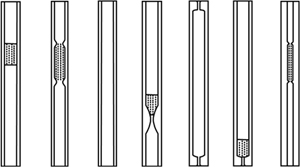
Quartz wool or no quartz wool?
The use of quartz wool in a liner has been of much debate and there are many advantages of using wool. The quartz wool acts as a crude filter for the analytical column and minimizes the chances of any particulate or non-volatile material from reaching the column. If the quartz wool is positioned so that the needle tip is in the centre of the wool mass, the wools large surface area helps in the efficient vaporization of the sample. The quartz wool also promotes mixing in the liner, which has a short sample residence time. The needle tip is wiped on the wool as the needle is withdrawn, allowing all the sample to be vaporized. To prevent sample degradation the wool in the liner has to be deactivated. The quartz wool used in SGE liners is fully deactivated in situ, it is still recommended not to use wool if analyzing low level pesticides such as DDT or Endrin.
Taper at the bottom
A taper at the bottom of the liner acts as a feed-in for the capillary column and reduces the amount of dispensed liquid hitting the bottom of the injector. If the quartz wool is packed loosely, then the taper prevents the wool moving out of the liner which might happen during high pressure injection techniques eg. pulsed splitless injection.

Restrictions, baffles, cups, complex forms, etc. in the liner without quartz wool
All these complex forms of liner can promote vaporization and mixing of the formed vapors which will minimize mass discrimination. One of the key functions of the inlet liner is for representative transfer of the sample from the syringe into the capillary column. If a reduced quantity of high molecular weight components are transferred then this is known as high molecular weight mass discrimination. Liner design and quartz wool can both promote mixing and minimize mass discrimination.
Discrimination - liner type
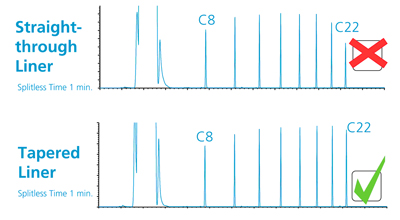
Taper at the top
The taper at the top can be used to minimize the effect known as Flashback. This occurs when an excessive amount of liquid is injected into the liner and the volume of the vaporized gas is larger than the volume of the liner. The gas can then escape back out of the liner into the inlet lines and cause contamination. The taper at the top reduces this effect by acting as a partial lid on the liner.
Inner diameter
The inner diameter will obviously determine the volume capacity of the liner. Therefore for a liquid volume greater than 2 µl, the liner ID should be as large as possible. Remember, when the liner ID is halved, the subsequent liner volume is reduced to one quarter of the original. The other important consideration for liner ID is the velocity of the carrier gas through the liner. A smaller ID will result in a higher velocity of gas and this means faster analyte transfer and therefore sharper peaks, especially for early eluting components. The transfer rate is more critical in splitless injection because the liner flow is equal to the column flow and is low. A smaller ID can have a dramatic effect of peak shape as shown below.
Deactivation
Deactivation is more critical during splitless injection than split injection. In splitless injection, the split vent is usually closed for about 1 minute, resulting in a low liner gas flow. A low gas flow will result in slow transfer and the residence time of analytes within the liner is increased. Therefore for thermally labile and heat sensitive compounds, the interaction time of the analyte with the inner surface of the glass liner is increased and this enhances breakdown. The effect is not nearly as pronounced in split injection because the residence time in the liner is very short.
SGE's effective liner solution

The SGE FocusLinerTM addresses all attributes of an effective liner by using a simple but effective design by where the quartz wool is held in the correct position by means of two tapered sections in the liner. The tapered sections are located to ensure the needle tip penetrates the quartz wool at the optimum position every time allowing the needle tip to be wiped consistently. As seen below the %RSD values for active compounds have been determined when injecting into liners with the quartz wool in different positions. From this you can see that the FocusLinerTM provides the most accurate and reproducible results when compared with a glass frit liner and a liner with quartz wool located in the middle.
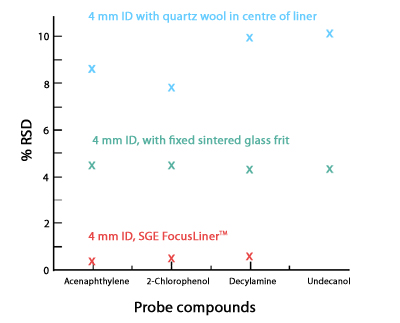
For more information on SGE FocuslinersTM please contact us and remember that no matter how good the deactivation of the liner, its design, or the number of samples injections, it will need to be changed on a regular basis to achieve optimum chromatography.
FocusLiner
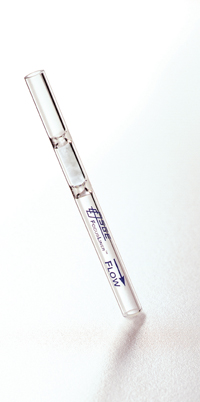 The FocusLiner™ is the first liner in the world to secure quartz wool by means of a tapering above and below the wool. This ensures the wool remains in the correct position to wipe the needle tip during injection. Reproducibility is greatly improved with chromatographers reporting Relative Standard Deviations (RSD's) of between 0.3 and 0.7%.
The FocusLiner™ is the first liner in the world to secure quartz wool by means of a tapering above and below the wool. This ensures the wool remains in the correct position to wipe the needle tip during injection. Reproducibility is greatly improved with chromatographers reporting Relative Standard Deviations (RSD's) of between 0.3 and 0.7%.
The new Fast FocusLiner™ has a narrow ID (<2.5 mm) making it ideal to be used with Fast Capillary Columns (0.1 mm ID).
Main features
- All liners deactivated with high temperature deactivation
- Innovative designs
- Excellent reproducibility, precision, accuracy and reliability
- Simple to use
- Maximum sensitivity / detection levels
- Guaranteed to fit
- Guaranteed premium inertness
If you are interested in this liner, you can select the right one for your GC in the product catalogue.





 0
0
 0
0